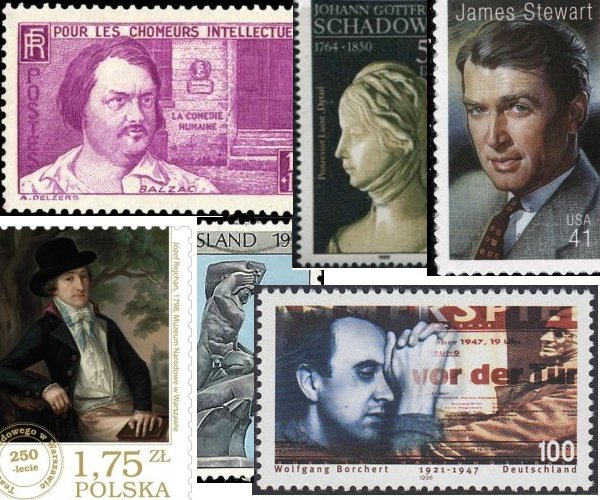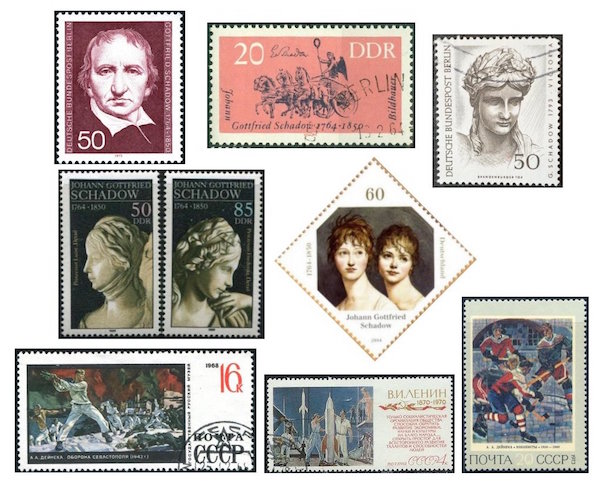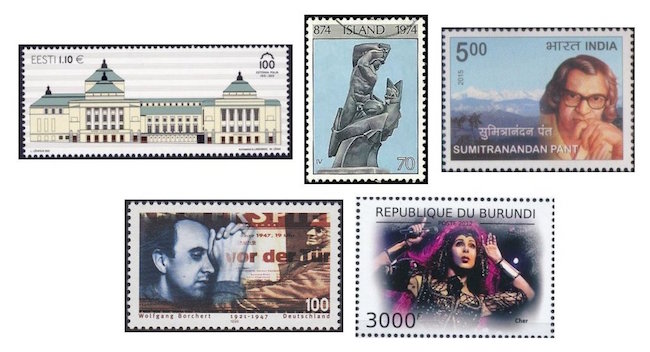The Arts on the Stamps of the World — May 20
An Arts Fuse regular feature: the arts on stamps of the world.

By Doug Briscoe
On this May 20th we begin with Honoré de Balzac, Sigrid Undset, and Jimmy Stewart before moving on to other artists of note on stamps of the world.
In a letter of 1837, Honoré de Balzac (20 May 1799 – 18 August 1850) wrote: “Beethoven is the only man who has made me feel jealousy. There is in that man a divine power.” Much of Balzac’s work is infused with discussions of musical matters and the names of composers, and the novels and stories of the huge series La Comédie humaine have in turn provided some fodder for opera librettists. The first opera based on Balzac seems to have been Le shérif by Halévy (1839), set to a libretto by Eugène Scribe after Balzac’s novella Maître Cornélius. In the 1930s both Darius Milhaud (Le faiseur, 1935) and Othmar Schoeck (Massimilla Doni, 1937) turned to Balzac’s works. The most recent Balzac opera I could find is Die tödlichen Wünsche (1959) by Giselher Klebe (1925–2009). Besides all this, Dmitri Shostakovich wrote incidental music to a play based on La comédie humaine (1934).

Gosh, I think ten whole days have passed since we last paid tribute to a Nobel Prize laureate. Norwegian novelist Sigrid Undset (20 May 1882 – 10 June 1949) won the award in 1928, mainly for her trilogy Kristin Lavransdatter, set in the Middles Ages. By the time she wrote this epic 1400-page work, she was well versed in her subject matter, having immersed herself in Old Norse manuscripts and Medieval chronicles and having published a Norwegian retelling of the Arthurian legends. Moreover she had already written a similar historical novel—admittedly a much less accomplished effort—when she was in her teens and early twenties. Undset was born in Denmark but grew up in Kristiania (Oslo). Her first published novel raised eyebrows with its central topic: adultery. This and her subsequent books (novels and stories) had contemporary settings. Although both her parents had been atheists, Undset was troubled by the 20th-century’s decline of ethical standards and the cataclysm of the First World War, and she turned, unexpectedly for staunchly Protestant Norway, to Catholicism. Naturally this philosophical upheaval found its way into her fiction. The Second War, however, seems to have broken her spirit. She fled to Sweden, then the United States, but not before her elder son was killed in the brief fighting between the Norwegian army and the invading Germans. Having always been a strong advocate of women’s rights, Undset now pleaded for American intervention and the rescue of the Jews. It seems the only things she wrote while in New York were some articles, most of them for a Catholic newsletter, and after her return to Norway in 1945 she wrote nothing more.
Beloved and admired American actor Jimmy Stewart was born 109 years ago today (May 20, 1908) in a town called Indiana, which happens to be in Pennsylvania. A youngster of diversified interests, he wanted to learn piano but settled for the accordion and was involved in school football, track, glee club, and a literary society besides being art director for the yearbook. He yearned to be a pilot. By the time World War II broke out he had for years been an accomplished flyer. Not only was he the first major American actor to join up (as a private), but he rose (long after war’s end, in the reserve) to the highest rank ever held by an actor, brigadier general. Stewart was a Nixon and Reagan supporter and once had a fistfight with his dear friend Henry Fonda over politics! Both men were honored, just two years apart, in the ongoing Legends of Hollywood stamp series: Fonda in 2005, Stewart in 2007. James Maitland Stewart died on July 2, 1997 at the age of 89.
English portrait painter Francis Cotes (20 May 1726 – 16 July 1770) worked for years in pastel, only turning to oils as a means of broadening his scope. Meeting with considerable success, he was a co-founder and later director of the Society of Artists of Great Britain and an early member of the Royal Academy. The stamp from Cuba shows a Cotes painting, Daniel Collyer, that hangs in Havana’s National Museum. The MFA holds a couple of the artist’s other portraits.
The Polish painter Joseph Reichan (or Rejchan) died on this date in 1818. Born in 1762 or 1763 to a painter father, he was severely wounded as an artilleryman during the Kosciuszko Uprising in 1794. He recovered and settled in Lviv, where he died. Like Cotes, he was primarily a portrait painter but also executed religious and genre paintings. Perhaps his best known work is the portrait he did in 1798 of theater director Wojciech Bogusławski (of whom we read here last month). It is this work that appears on the recent Polish stamp.

German sculptor Johann Gottfried Schadow (20 May 1764 – 27 January 1850) is amply represented on stamps of the two Germanies. Born to a poor tailor in Berlin, Schadow was offered the hand of his prominent teacher’s daughter but instead eloped with a Jewish girl to Vienna, whereupon his father, rather than disinherit him, as you might expect, sent him money with which he could continue his studies in Italy. Schadow remained there three years, returning to Berlin in 1788, where he promptly succeeded his teacher as sculptor to the Prussian court. He was a friend of Goethe, of whom Schadow made a bust and a dozen medallions. He also left over 2000 lithographs and drawings, including one of Harry Maitey, the first Hawaiian to visit Prussia. Maitey was of particular interest to Schadow, a student of physiognomy who wrote extensively on that subject, the human figure, and his method. OK, let’s get to the goods. First comes a self-portrait, then one of Schadow’s most public works, the quadriga that sits atop the Brandenburg Gate in Berlin, with another stamp offering a close-up of the Head of Victory from the same work. A pair of DDR issues yields the heads from his Prinzessingruppe, a statue of the daughters of the Duke of Mecklenburg-Strelitz. Another pair of pretty heads appears on the most recent Schadow stamp from 2014, but I wasn’t able to identify the piece by name.
Soviet Russian painter Aleksandr Deyneka (May 20, 1899 – June 12, 1969) was also a sculptor and graphic artist. Like Tuesday’s Aleksandr Laktionov, he was a prominent practitioner of Socialist Realism. One of his most celebrated works is The Defense of Sebastopol (1942); next to that we have Mastery of Space (1961), and finally one of Deyneka’s sports pieces, a mosaic of Hockey Players (1959-60).
Wivi Lönn (20 May 1872 – 27 December 1966) was the first woman in Finland to operate her own architectural firm and to be granted the honorary title of professor by the Finnish Association of Architects. She attended the the Industrial School of Tampere and the Polytechnic University of Helsinki. She collaborated with Armas Lindgren in designing and building the Estonia Theater (1909-13) in Tallinn, which now houses the Estonian National Opera and the Estonian National Symphony Orchestra. (It was severely damaged in a Soviet air raid during World War II and substantially redesigned.) This is the building shown on the recent Estonian stamp.

Icelandic sculptor Ásmundur Sveinsson (May 20, 1893 – December 9, 1982) spent time in Copenhagen, Stockholm, and Paris before returning to his native country in 1929 and embarking on a series of abstract figures frequently representing working men and women. His later work became almost fully abstract. Sæmundur Riding the Seal comes from his earlier period, 1927. The story it tells comes from Icelandic legend: Sæmundur the Learned promised the devil his soul in return for transporting him across the sea without getting him wet. The devil transformed himself into a seal, and off they went. Just as they were coming to the shore, Sæmundur, who had been reading his psalter on the journey, fetched the devil a smack on the head with the psalter, causing the devil/seal to flounder and thus cheating him of his bargain. The statue stands on the campus of the University of Iceland in Reykjavík.
The mother of Indian poet Sumitranandan Pant (May 20, 1900 – December 28, 1977) died in childbirth, but otherwise he grew up in comfortable circumstances and developed a love for natural beauty. He studied at Queens College in Banaras and Muir College in Allahabad in 1918-19. The publication of his poetry collection Pallav in 1926 made his name. He became one of the principal voices of the Neo-Romantic Chhayavaadi school of Hindi literature. His stamp was issued just two years ago.
The short life of Wolfgang Borchert (20 May 1921 – 20 November 1947) was plagued with troubles. Born to liberal intellectual parents, he missed so many meetings of his Hitler Youth unit that they drummed him out. In 1940 the Gestapo arrested him, the first of his numerous run-ins with the Nazi authorities. He was just beginning his career as a stage actor when he was drafted and sent to the dreaded Eastern front, where he was accused of a self-inflicted wound, then, exonerated, was sent back only to come down with frostbite and hepatitis. Borchert acted a bit more in war-torn Hamburg before his war ended with his unit’s surrender to the French. He escaped and walked about 370 miles back home. He died of liver failure in a sanatorium at the age of 26. His output was necessarily small but potent. It includes a play, The Man Outside (Draußen vor der Tür, 1947, referenced on the stamp), a poetry collection, Lantern, Night and Stars (Laterne, Nacht und Sterne, 1946), an antiwar manifesto, Dann gibt es nur eins! (Then there is only one thing!), and a number of uncompromising humanistic stories, one of the most famous of which, “Das Brot” (“The Bread”, 1946), I remember being assigned to read in a college German class forty years ago…
Happy birthday to Cher (born Cherilyn Sarkisian 71 [!] years ago today). Her image appears on a stamp from a block of American entertainers issued by Burundi five years ago.
Wikipedia tells us that on this day in 1609, “Shakespeare’s sonnets [were] first published in London, perhaps illicitly, by the publisher Thomas Thorpe.”
A graduate of the University of Massachusetts with a B.A. in English, Doug Briscoe worked in Boston classical music radio, at WCRB, WGBH, and WBUR, for about 25 years, beginning in 1977. He has the curious distinction of having succeeded Robert J. Lurtsema twice, first as host of WGBH’s weekday morning classical music program in 1993, then as host of the weekend program when Robert J.’s health failed in 2000. Doug also wrote liner notes for several of the late Gunther Schuller’s GM Recordings releases as well as program notes for the Boston Classical Orchestra. For the past few years he’s been posting a Facebook “blog” of classical music on stamps of the world, which has now been expanded to encompass all the arts for The Arts Fuse.
